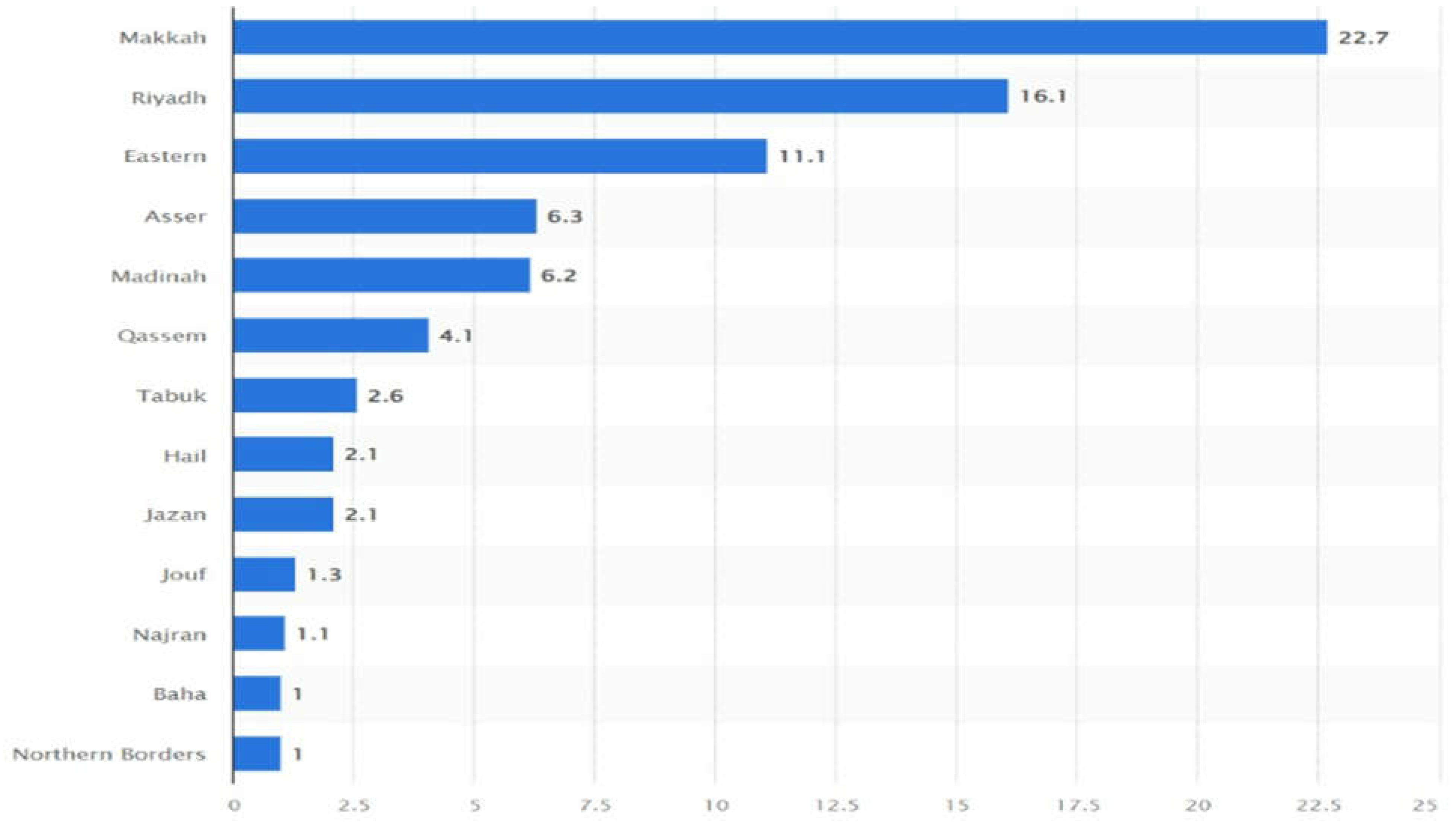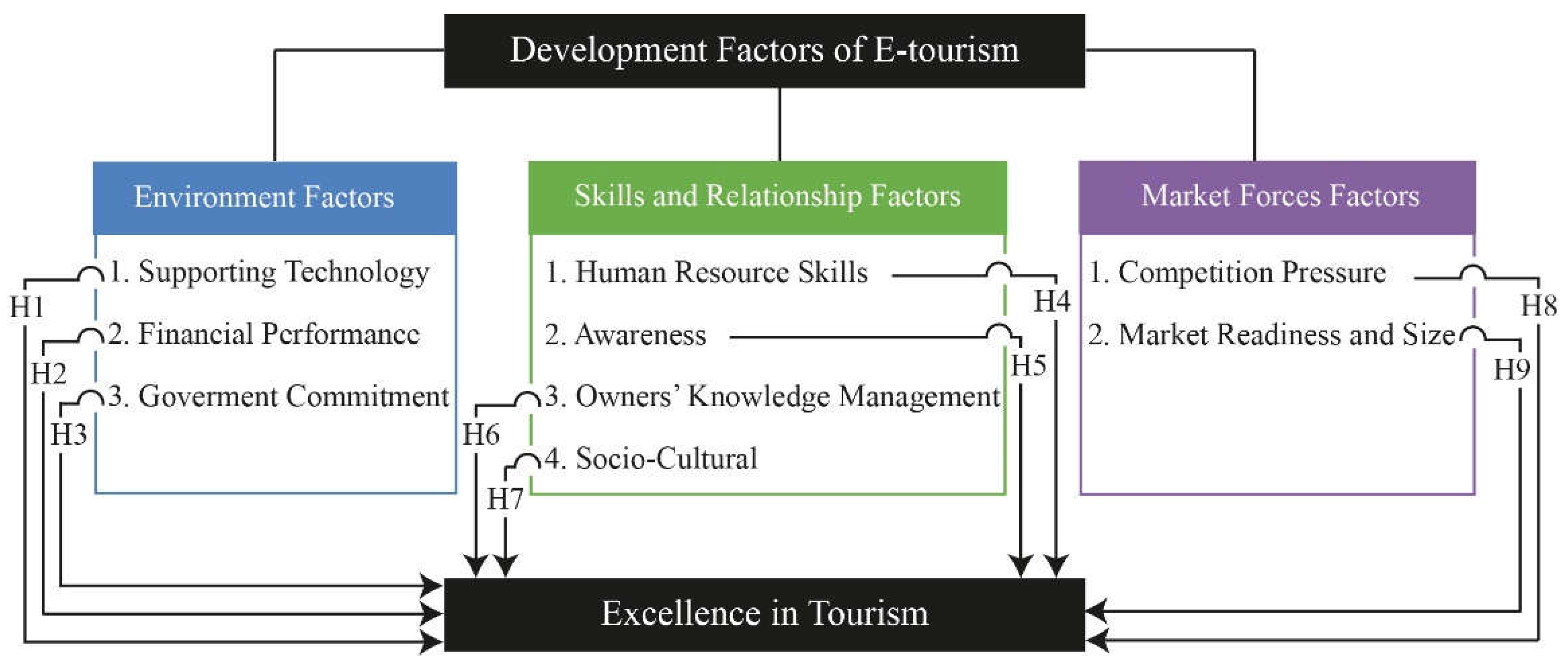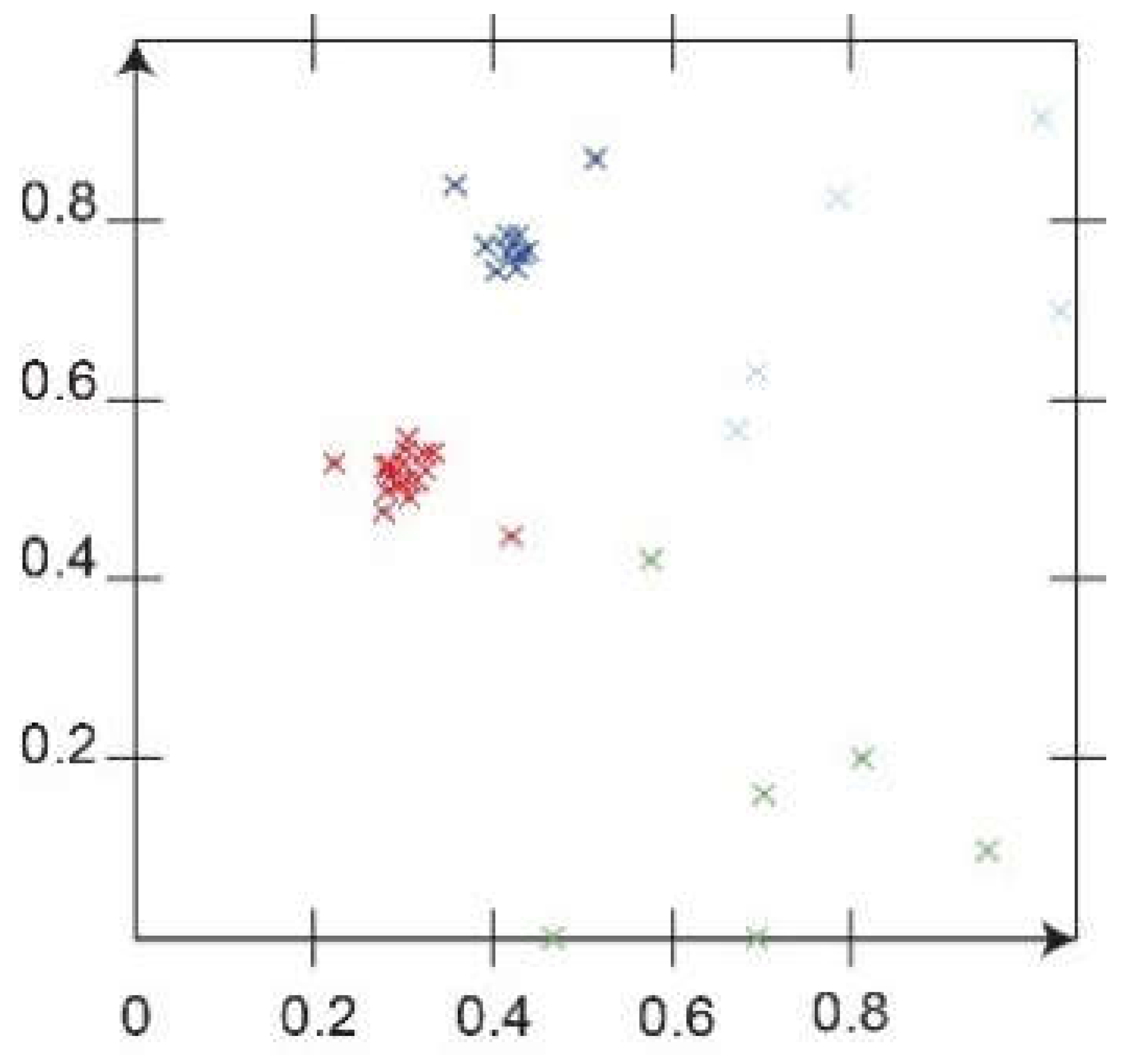Submitted:
20 May 2024
Posted:
20 May 2024
You are already at the latest version
Abstract
Keywords:
1. Introduction
2. Review of the Literature
2.1. Theoretical Background of E-tourism
2.2. Sustainable Development in Tourism
2.3. Tourism in the Ha'il Region
3. Conceptual Model and Hypothesis
3.1. Conceptual
3.1.1. Supporting Technology
3.1.2. Financial Performance
3.1.3. Government Commitment
3.1.4. Human Resource Skills
3.1.5. Awareness
3.1.6. Owners’ Knowledge Management
3.1.7. Socio-Cultural
3.1.8. Competition Pressure
3.1.9. Market Readiness and Size
3.2. Hypothesis
4. Methodology
4.1. Measurement and Results of Statistical Analysis
4.1.1. Demographic Profile of the Respondents and Descriptive Statistics
4.1.2. Discussions of the Results of the First Analysis
4.2. Measurement and Analysis Using Artificial Intelligence Method
4.2.1. Proposed Method
4.2.2. Discussion of the Result of the Second Analysis
5. Conclusions and Recommendations
Funding
References
- Abdullaeva S. E., Oripova D. K., 2023, “Development of Main Directions for Achieving Sustainability in Tourism”, International Journal of Social Science Research and Review, Vol. 6, No. 6. [CrossRef]
- Aghili A., Arofzad S., Nazari R., 2022, “Sustainable Development According to Sport Tourism Business in Iran”, Sports Business Journal, Vol.3, Issue 1, No. 5.
- Anser M. K., Adeley B. N., Tabash M. I., Tiwari A. K, 2021, “Services trade–ICT–tourism nexus in selected Asian countries: new evidence from panel data techniques”, Current Issues in Tourism, Vol. 25, Issue 15.
- Ayed S. A., 2021, “The impact of e-commerce drivers on e-customer loyalty: Evidence from KSA”, International Journal of Data and Network Science, Vol. 6, Issue 1, pp. 73-80.
- Baloch Q. B., Saleh S. N., Iqbal N., Sheeraz M., Asadullah M., Mahar S., Khan S., 2023, “Impact Of Tourism Development Upon Environmental Sustainability: A Suggested Framework For Sustainable Ecotourism”, Environmental Science And Pollution Research, Vol. 30, pp. 5917-5930. [CrossRef]
- Buhalis D., Leung X. Y., Fan D., Darcy S., Chen G., Xu F., Tan G.W. H., 2023, “Editorial: Tourism 2030 and the contribution to the sustainable development goals: the tourism review viewpoint”, Tourism Review, Vol. 78, No. 2, pp. 293-313.
- Chams N., Blondon J. G., 2019, “On the importance of sustainable human resource management for the adoption of sustainable development goals”, Resources, Conservation and Recycling, Vol. 141, pp. 109-102.
- Chen J., Huang Y., Wu E., IP R.,Wang K., 2023, “How does rural tourism experience affect green consumption in terms of memorable rural-based tourism experiences, connectedness to nature and environmental awareness?”, Journal of Hospitality and Tourism Management, Vol. 54, pp. 166-177.
- Condratov I., 2013, “e-Tourism: Concept and evolution”, EcoForum, Vol. 2, Issue 1, pp. 58-61.
- Dias A., Rodriguez M. R. G., Hallak R., 2023, “Nascent entrepreneurship: a critical perspective and research agenda in tourism and hospitality”, International Journal of Contemporary Hospitality Management, Vol. 35, Issue 7.
- Eyisi A., Lee D., Trees K., 2023, “Local perceptions of tourism development and socio-cultural impacts in Nigeria”, Tourism Planning & Development, Vol. 20, Issue 4, pp. 499-521. [CrossRef]
- Fauzel S., Ragoobur V., 2023, “Sustainable development and tourism growth in an island economy: a dynamic investigation”, Journal of Policy Research in Tourism, Leisure and Events, Vol. 15, Issue 4, pp. 501-512.
- Fennel D., 2020, “Technology and the sustainable tourist in the new age of disruption”, Journal of Sustainable Tourism, Vol. 29, No. 4.
- Fong B., Olmedo E., Chang P. K., 2023, “YouTubers and the Malaysian Youths: An Exploration into Digital Parasocial Relationships: An Exploration into Digital Parasocial Relationships”, Journal of Ethnic and Diversity Studies, Vol. 1, Issue 1.
- Gamsakhurdia T., Fetelava S., 2023, “Financing of The Sustainable Tourism Industry in Georgia”, EBESCO, Deutsche Internationale Zeitschrift für Zeitgenössische Wissenschaft, No. 59, pp. 26-33.
- Gómez M., Pratt M. A., Molina A., 2018, “Wine tourism research: a systematic review of 20 vintages from 1995 to 2014”, Current Issues in Tourism,Vol. 22, Issue 18. [CrossRef]
- Gu X., Hunt C. A., Jia H., Niu L., 2022, “Evaluating Nature-Based Tourism Destination Attractiveness with a Fuzzy-AHP Approach”, Sustainability, Vol. 14, No. 13.
- Ji J., Yin J., 2022, “Diffusion Characteristics and Driving Factors of the Smart Tourism City Policy-Event History Analysis”, Sustainability, Vol. 14, No. 11.
- Kazandzhieva V., Santana H., 2021, “E-tourism: Definition, development and conceptual framework”, Tourism: An International Interdisciplinary Journal, Vol. 67, No. 4.
- Lama S., Prahadan S., Shrestha A., 2020, “Exploration and implication of factors affecting e-tourism adoption in developing countries: a case of Nepal”, Information Technology & Tourism, Vol. 22, pp. 5-32.
- Li Y., Liu Y., Solangi Y. A., 2024, “Analysis of Factors and Strategies for the Implementation of Sustainable Tourism in a Green Economic Structure in China”, Journal of Cleaner Production, Vol. 434.
- Liu H., Hasan M., Cui D., Yan J., Sun G., 2022, “Evaluation of tourism competitiveness and mechanisms of spatial differentiation in Xinjiang, China”, PLOS ONE, Public Library of Science, Vol. 17, No. 2, pp. 1-19.
- Lora A. V., 2023, “The societal impact of tourism research of the Research Excellence Framework 2021”, Journal of Policy Research in Tourism, Leisure and Events, Vol. 15, No. 4, pp. 502-512.
- Moncayo D. F., 2019, “Influence of electronic commerce in tourism”, Journal of Business and entrepreneurial studies, Vol. 3, No. 2.
- Myrovali G., Morfoulaki M., Mpaltzi T., 2023, “Can Destination Cards Help to Shape Areas’ Sustainability?”, Sustainability, Vol. 15, No. 11.
- Nanda W. D., Widianingsih I., Miftha A. Z., 2023, “The Linkage of Digital Transformation and Tourism Development Policies in Indonesia from 1879–2022: Trends and Implications for the Future”, Sustainability, Vol. 15, No. 13. [CrossRef]
- Oyabu T., Nambo H., Kimura H., Liu A., 2022, “Statistical relation between foreign visitors to Japan for business and the amount of Japan's total trade”, Journal of Global Tourism, Vol. 7, No. 2, pp.119-123. [CrossRef]
- Preko A., Amoako G. K., Dzogbenuku R. K., Kosiba J., 2022, “Digital tourism experience for tourist site revisit: an empirical view from Ghana”, Journal of Hospitality and Tourism Insights, Vol. 6, Issue 2, pp. 779-796. [CrossRef]
- Rahimi M. K., Safaghat T., Beiginia A., Jafari H., 2022, “Investigating the Marketing Status of Healthcare Tourism of Selected Public and Private Hospitals in Yazd in 2021”, Journal of health research in community, Mazandaran University of Medical Sciences, Vol. 8, Issue 1, pp. 60-68.
- Saad A., Gharaibeh B., 2023, “E-tourism adoption in travel agencies: new qualitative insights from a developing country”, International Journal of Tourism Policy, Vol. 13, No. 3, pp. 248-261.
- Santos F. D., Lunardi G. L., Maia C. R., Añaña E. S., 2020, "Factors that influence consumers’ participation in electronic tourism", RBTUR, Vol. 14, Issue 2, pp. 139-155.
- Shafiee S., Ghatari A. R., Hasanzadeh A., Jahanyan S., 2019, “Developing a model for sustainable smart tourism destinations: A systematic review”, Tourism Management Perspectives, Vol. 31, pp. 287-300. [CrossRef]
- Shrestha D., Jeong S. R., 2021, “An ICT Framework for Tourism Industry of Nepal: Prospect and Challenges”, Journal of Internet Computing and Services, Vol. 17, No. 6, pp. 113-122. [CrossRef]
- Spenceley A., Rylance A., 2019, “Chapter 8: The contribution of tourism to achieving the United Nations Sustainable Development Goals”, Collection of Social and Political Science, pp. 107-125.
- Streimikiene D., Svagzdiene B., Jasinskas E., Simanavicius A., 2020, “Sustainable tourism development and competitiveness: The systematic literature review”, Sustainable Development, Vol. 29, Issue 1, pp. 259-271. [CrossRef]
- Subramanian Y., Masron T. A., 2021, “The impact of tourism on entrepreneurship in developing countries”, Business Strategy and Development, Vol. 5, Issue 3, pp. 139-303.
- Vannieuwenhuyze A., 2019, “Intelligence Artificielle Vulgarisée—Le Machine Learning et le Deep Learning par la Pratique”, ENI : Strasbourg, France.
- Vouros A., Langdell S., Croucher M., Vasilaki E., 2021, “An empirical comparison between stochastic and deterministic centroid initialisation for K-means variations”, Mach. Learn. [CrossRef]
- Werthner H., 2022, ”A digital humanism view on e-tourism”, Information Technology & Tourism, Vol. 24, pp. 347-360. [CrossRef]
- Wu D., Li H., Wang Y., 2023, ”Measuring sustainability and competitiveness of tourism destinations with data envelopment analysis”, Journal of Sustainable Tourism, Vol. 31, Issue 6, pp. 1315-1335.




| # | 2019 | 2020 | 2021 | 2022 | 2023 |
|---|---|---|---|---|---|
| Domestic tourism trips | 973 | 1160 | 1860 | 2174 | 2582 |
| Inbound tourism to Ha’il | 15 | 10 | 90 | 105 | 124 |
| Tourism trip to work | 51 | 34 | 65 | 75 | 88 |
| Visiting friends and relatives | 716 | 869 | 1254 | 1580 | 1900 |
| Dimensions | Development Factors of E-tourism | Code | Description | References |
|---|---|---|---|---|
| Environment Factors | Supporting Technology | ST | Capability to implement technology to develop e-tourism | [26,33,36] |
| Financial Performance | FP | Financial performance of the institution to develop e-tourism | [18] | |
| Government Commitment | GC | Local motivation provided by the government for e-tourism. | [20] | |
| Skills and Relationship Factors | Human Resources Skills | HRS | Human resource skills and competencies required to develop e-tourism | [39] |
| Awareness | AW | Degree of awareness, ease, and confidence in the adoption of e-tourism | [4,30] | |
| Owners’ Knowledge Management | OKM | Owners’ knowledge and information about e-tourism and its benefits and uses | [20] | |
| Socio-Cultural | SC | Degree of perception of culture, language, perceived benefits, thinking on e-tourism | [11] | |
| Market Forces Factors | Competition Pressure | CP | Pressure to develop the adoption of e-tourism because of competition | [20,28] |
| Market Readiness and Size | MRS | Degree of market readiness to develop e-tourism | [20] |
| Number | Demographic Factors | Category | Frequency | Percent |
|---|---|---|---|---|
| 1 | Gender | Male | 317 | 74.4 |
| Female | 109 | 25.6 | ||
| 3 | Age | 18 to 30 years | 173 | 40.6 |
| 30 to 40 years | 138 | 32.4 | ||
| 40 to 50 years | 70 | 16.4 | ||
| Above 50 years | 45 | 10.6 | ||
| 4 | Experience in tourism (Work Experience) | Less than 1 year | 44 | 10.3 |
| 1 to 5 years | 198 | 46.5 | ||
| 5 to 10 years | 95 | 22.3 | ||
| Above 10 years | 89 | 20.9 | ||
| 5 | Nationality | Saudi | 127 | 29.8 |
| Non-Saudi | 299 | 70.2 |
| # | Mean | St Deviation | α Crombach | AVE | ET | ST | FR | GC | HRS | AW | OKM | SC | CP | MRS |
|---|---|---|---|---|---|---|---|---|---|---|---|---|---|---|
| ET | 3.996 | 0,660 | 0,903 | 0.862 | 1 | |||||||||
| ST | 4.018 | 0.674 | 0.900 | 0.898 | 0.878 0.000 | 1 | ||||||||
| FP | 3.051 | 0.833 | 0.873 | 0.865 | 0.295 0.000 | 0.278 0.000 | 1 | |||||||
| GC | 3.593 | 0.768 | 0.868 | 0.864 | 0.329 0.000 | 0.275 0.000 | 0.402 0.000 | 1 | ||||||
| HRS | 4.078 | 0.624 | 0.867 | 0.862 | 0.835 0.000 | 0.891 0.000 | 0.285 0.000 | 0.334 0.000 | 1 | |||||
| AW | 3.641 | 0.745 | 0.835 | 0.861 | 0.286 0.000 | 0.333 0.000 | 0.393 0.000 | 0.304 0.000 | 0.387 0.001 | 1 | ||||
| OKM | 2.785 | 0.757 | 0.831 | 0.861 | 0.489 0.000 | 0.259 0.000 | 0.762 0.000 | 0.351 0.000 | 0.242 0.000 | 0.344 0.000 | 1 | |||
| SC | 3.827 | 0.679 | 0.872 | 0.861 | 0.489 0.000 | 0.453 0.000 | 0.243 0.000 | 0.248 0.000 | 0.429 0.000 | 0.283 0.000 | 0.235 0.000 | 1 | ||
| CP | 3.500 | 0.817 | 0.873 | 0.886 | 0.403 0.000 | 0.334 0.000 | 0.395 0.000 | 0.826 0.000 | 0.374 0.000 | 0.283 0.000 | 0.346 0.000 | 0.259 0.000 | 1 | |
| MRS | 2.809 | 0.802 | 0.775 | 0.824 | 0.243 0.000 | 0.268 0.000 | 0.291 0.000 | 0.262 0.000 | 0.248 0.000 | 0.283 0.000 | 0.346 0.000 | 0.305 0.000 | 0.124 0.000 | 1 |
| # | B | St-Error | Standardized Coef. Beta | T | Sig |
|---|---|---|---|---|---|
| ST | 0.606 | 0.480 | 0.618 | 12.686 | 0.000 |
| CP | 0.706 | 0.190 | 0.940 | 3.961 | 0.000 |
| HRS | 0.221 | 0.520 | 0.208 | 4.267 | 0.000 |
| SC | 0.930 | 0.240 | 0.096 | 3.882 | 0.000 |
|
ANOVA Sum Square Mean Square F Sign |
148.7222 37.181 423.767 0.000 |
||||
|
Model Regression R R-Square Adjusted R Square R Square Change F Change |
0.895 0.801 0.799 0.007 15.068 |
||||
| Development Factors of E-tourism | Sustainable Development Goals (SDGs) | References |
|---|---|---|
| Supporting Technology (ST) | SDG12 | [32] |
| Financial Performance (CP) | SDG8 | [15] |
| Government Commitment (GC) | SDG12 | [6] |
| Human Resource Skills (HRS) | SDG8 | [7] |
| Awareness (AW) | SDG8 | [10] |
| Owners’ Knowledge Management (OKM) | SDG8 | [34] |
| Socio-Cultural (SC) | SDG12 | [8] |
| Competition Pressure (CP) | SDG8 | [40] |
| Market Readiness and Size (MRS) | SDG8 | [22] |
| Development Factors of E-tourism | Sustainable Development Goals (SDGs) |
|---|---|
| Supporting Technology (ST) | SDG12 |
| Competition Pressure (CP) | SDG8 |
| Financial Performance (FP) | SDG8 |
| Human Resource Skills (HRS) | SDG8 |
| Government Commitment (GC) | SDG12 |
Disclaimer/Publisher’s Note: The statements, opinions and data contained in all publications are solely those of the individual author(s) and contributor(s) and not of MDPI and/or the editor(s). MDPI and/or the editor(s) disclaim responsibility for any injury to people or property resulting from any ideas, methods, instructions or products referred to in the content. |
© 2024 by the authors. Licensee MDPI, Basel, Switzerland. This article is an open access article distributed under the terms and conditions of the Creative Commons Attribution (CC BY) license (http://creativecommons.org/licenses/by/4.0/).





